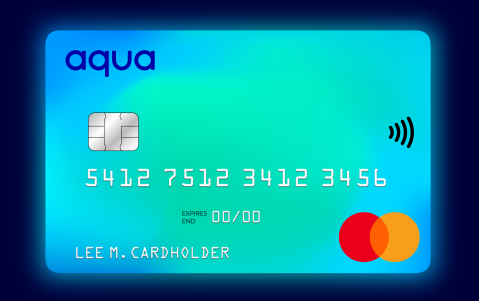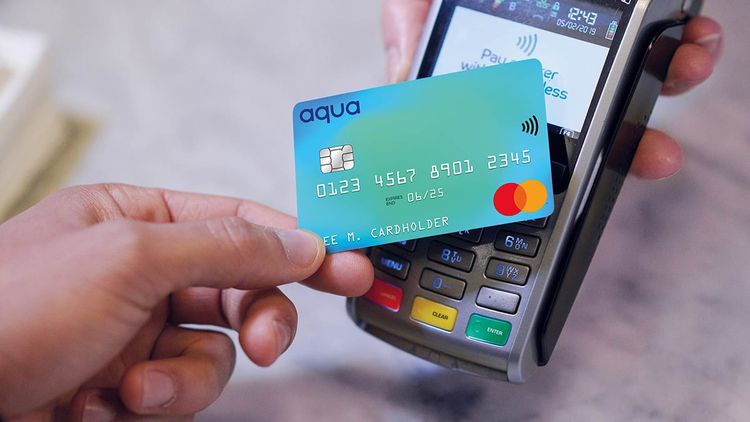Credit cards
Aqua is the smart way to build better credit
An Aqua credit card gives you the power to improve your credit score – backed by expert support, personalised limits and a secure app

Why should I apply for an Aqua credit card?
Safe and secure
With our 24/7 fraud protection, we’ll help you keep your account safe and our friendly team can support you if you ever need us.
Personalised credit limits
We’ll adjust your credit limit as we get to know you and could even increase it if you manage your account well.
Expert support and tools
Join the hundreds of thousands of people improving their credit score with our support and tools, including free credit score updates in the Aqua app.
34.9% APR Representative (variable) for Aqua Classic
Check your eligibility for Aqua with no impact to your credit score
How do credit cards work?
Credit cards work by lending you up to a maximum amount known as a credit limit. Your credit limit is personalised to your circumstances and it could even grow over time if you manage your account well.
Whether you need to make payments online, at the shops, or in your favourite restaurant, a credit card offers a flexible way to borrow money as and when you need it.
If you only use your account for purchases and you pay back what you borrow in full each month, you usually won’t pay interest. Or if you prefer, you can carry forward your balance and pay interest each month. Bear in mind that you must still pay at least your minimum monthly payment - and more when you’re able to. Here’s more on how credit cards work.

How you can apply for an Aqua credit card
Apply today with an eligibility check in as little as 60 seconds – with no impact on your credit score. If your application is approved, and you’ve accepted the credit limit offered, we’ll pop your new Aqua card in the post. You could be on your way to building better credit before you know it.
Aqua Classic FAQs
Credit on a credit card is the amount of money you’re able to spend or ‘borrow’ with the option to repay over time. Your available credit is your ‘credit limit’ minus any money you’ve already spent and any charges you’ve incurred, less any payments you’ve made. The amount you can borrow from a lender is determined by a range of factors, including your credit score. A higher score means lenders are more likely to lend to you, and at the best rates, with credit limits adjusting depending on how well you manage your account and how much the lender thinks you can afford. If you’re an Aqua customer, you can check your credit score anytime in the Aqua Coach tab of the Aqua app.
The APR on a credit card is the cost of borrowing money over a year. There are two types of APRs, Representative APR and personal APR. The Representative APR (Annual Percentage Rate of Charge) is used by lenders to help you understand the cost of borrowing before you apply. Stated as an annual figure, it includes the card interest rate and any mandatory fees (such as an annual fee), to help you compare the cost of different cards. Other occasional charges such cash withdrawal or default fees are not included in the APR as they do not apply to every customer. The actual rate you are given after applying for the card is your Personal APR and may differ. Learn more about APR.
You can apply for a credit card if you are at least 18 years of age, although most credit card providers will also require that you’re in employment and earning a minimum amount. While this is the minimum requirement, there are things you can do to increase your chances of eligibility for a credit card, such as getting on the electoral register, not applying for credit too often and building a good credit history.
You can apply for an Aqua credit card as long as you:
- Are aged 18 and over
- Have a permanent UK address
- Haven’t been registered bankrupt in the past 18 months and don’t have ongoing bankruptcy proceedings against you
- Have a current UK bank or building society account
- Haven’t received a County Court Judgement (CCJ) in the past 12 months
- Don’t already have an Aqua card and haven’t taken out an Aqua, marbles, opus, Fluid or Bip card in the past 12 months
Before you apply, you’ll need to check your eligibility. You can do this using our SafeCheck which has no impact on your credit score. Here’s more on how to apply for a credit card.
Before applying for a credit card, you should check your eligibility using a soft- check eligibility checker, such as our own SafeCheck. A soft eligibility check will show your likelihood of being accepted without affecting your credit score. You’ll be able to see the check on your credit report, but lenders won’t – and it won’t impact your credit score. It’s important to remember a soft check will only tell you your chances of acceptance for a credit card. You will still need to apply for the card, which requires a full credit check and will leave a hard search on your credit report.
A credit card application doesn’t take long to complete and you’ll usually be told instantly if you’re approved, with a new card arriving in the post within a week or two. For security, you’ll receive your PIN separately. In some cases, a lender may need to take a closer look at your application and the process could take longer.
Most credit card providers will let you spend on your credit card abroad but will usually charge a foreign transaction fee, so be sure to check before you travel. It’s also a good idea to check whether your specific type of card is accepted in the country you’re visiting. While Visa and Mastercard are accepted worldwide, other types of credit cards may not be as widely accepted in certain regions. Learn more about using a credit card abroad.
Aqua card is a Mastercard accepted in more than 36 million places and over 600,000 cashpoints around the world. Depending on your type of Aqua card, you may incur a charge for any purchase made in a foreign currency. This will be added to your purchase payment and will not appear separately on your statement. You can learn more about using your Aqua card abroad in the Summary Box.
The difference between a credit and a debit card is that a credit card allows you to borrow a set amount of money from a lender, while a debit card allows you to spend money from your own funds. When you make purchases on a credit card, you borrow money from the lender, which is usually repaid with interest and may incur additional fees. A debit card, on the other hand, allows you to make payments by directly deducting money from your current account. Here’s more on the difference between a credit and a debit card.
A credit limit is the maximum amount you can spend on a credit card. If you manage your account well, your credit limit might grow, meaning you can borrow more money from your lender. When applying for a credit card, your lender will set a credit limit based on a range of factors including your income, debts, and credit history. Most lenders will tell you the range of credit limits available on any given product before you sign the agreement. However, you won’t always find out your individual credit limit until you’ve applied and have been accepted.
Get more help improving bad credit
Slide 1 of 3Check out our range of guides with helpful tips and advice to get you on the path to building better credit.

How to get a credit card with bad credit
Learn how to choose and apply for a credit card when you have bad credit.
Victoria Smith

What is a credit card and how do they work? -...
Discover the basics of credit cards, how to use them, and the benefits of using credit cards in our comprehensive g...
Hayley Bevan

Understanding types of credit cards
Find out more about the common types of credit cards and which is right for you.
Vanessa Stewart